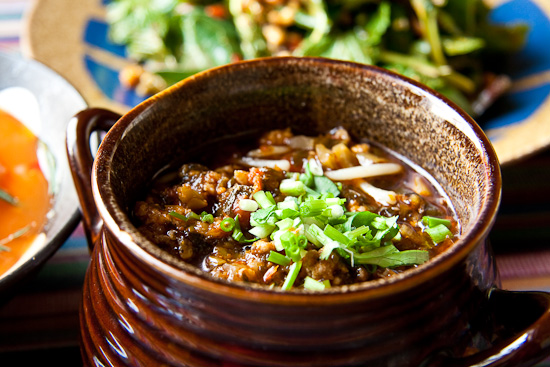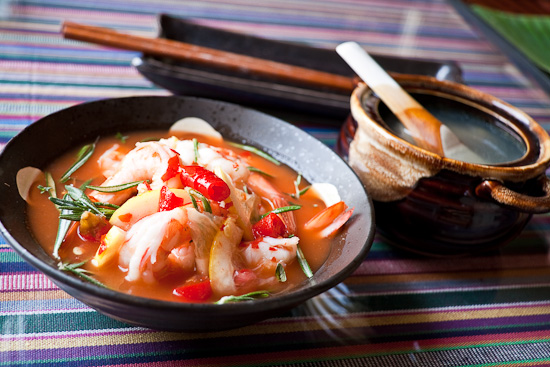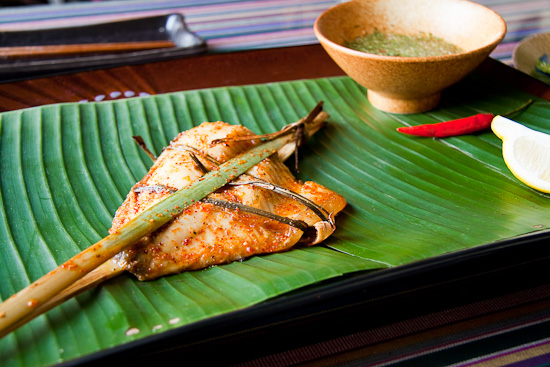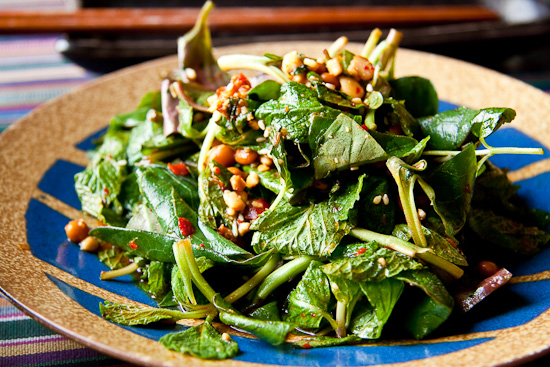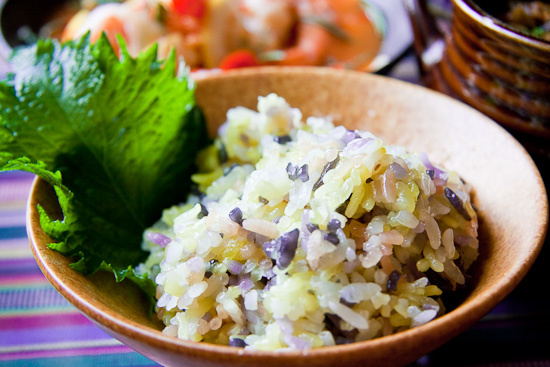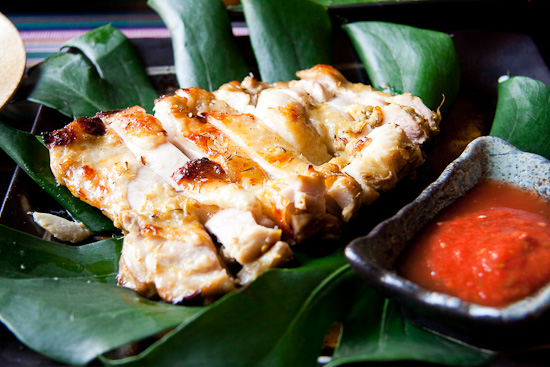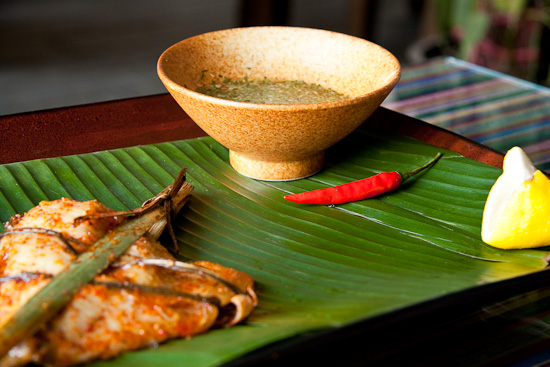I love food, and I love Beijing’s beautiful old courtyard houses, but it seems like when these two things meet, you’re more likely than not to get a well-designed environment and exquisite, limp food suffering from several cases of schizophrenia. So I was initially skeptical of Dianke Dianlai – contemporary Yunnan in a restored courtyard? Sounds like we’d be paying lots of money to nibble on stylish rice noodle sculptures.
But I needn’t have worried; the chefs are from Yunnan, and so is the owner – a decided rarity in Beijing. The food is creative and modern while staying true to the province’s bold, sassy spice melangé. It even manages to capture some of the diversity of Yunnan food – with 24 different ethnic groups, there’s perhaps as much variety here as in a small country. The innovations, like touches of rosemary and thyme, are subtle; everything works together, and there’s little reliance on frou-frou gimmicks¹. In fact, Dianke Dianlai might even be my favorite new Yunnan restaurant, always excepting those unshakeable classics Yunteng Shifu and Baoqin Daiwei of course.
We chose the RMB 98 per person set meal (RMB 198 is also available), and received eight courses in all, some portioned individually and some for sharing. There was more than enough for the two of us, but fortunately I can always count on my dining partner to pick up the slack.
First up was cold poached shrimp in a tomato broth flavored with rosemary, thyme, lemons, and chile peppers. This “sour soup shrimp” (suantang xia 酸汤虾) was like a refined twist on the southwestern China classic suantang yu, a whole fish served in a bubbling, mouth-puckering hot pot. The broth is a delight on its own: intense and aromatic and tantalizingly reminiscent of sriracha sauce – I was blown away. Sriracha sauce was the first hot sauce I had ever tried – I would steal it from my dad when my mom wasn’t looking – but even if you don’t have fond memories of the plastic bottle with the rooster and green squeeze top, this soup is worth savoring. I could drink a whole bowl of this, shrimp or no shrimp.
Behind it in the same picture is a little crock of “old goose soup,” (lao e tang 老鹅汤), simmered slowly over many hours. This was very xian (鲜), the Chinese equivalent of umami. It was tasty, but perhaps not necessarily better than steam-pot chicken (qi guo ji 汽锅鸡), cooked until tender in an earthware pot in which the steam can circulate.
Chinese meals don’t set any store on the order of the courses: at a restaurant you might find your sweets arriving before your main, and the rice not appearing until the very end (unless you bug them). The ideal, of course, is to have all the dishes be present at the same time, and for people to eat whatever they like in whatever succession they desire. Next to come was our fish (xiangmao kao luofei yu 香茅烤罗非鱼), a beautiful, grilled tilapia, skewered between bamboo, tied with lemongrass, and rubbed with the most delightful spices ever. What were they? I couldn’t tell, and the waitresses said it was a house secret. The chefs had not only coated the surface of the fish, but also stuffed the interior with spices, so every bite was a small flavor explosion. As for the tilapia itself, it was flaky and tender, and not a whit overcooked. There was a zhanshui (蘸水) sauce for dipping – a classically Yunnan blend of spices, including plenty of chile peppers – but with fish this good, it wasn’t really necessary, unless you crave that extra pepper kick.
A riff on the mint salad was made with the addition of fermented soy beans (shuidouchi 水豆豉) and zhe’ergen (折耳根) leaves – the green shoots of a plant better known as stinky fish grass (yuxing cao 鱼腥草). This was the first time I had ever seen anyone eat zhe’ergen leaves, which turned out to be surprisingly normal compared to the pungent roots that really do smell of fish. Crisp and refreshing, with punches of saltiness from the soybeans.
Grilled fish and mint salads are Yunnan restaurant staples, but I was really delighted to see dishes that one can’t normally find in Beijing – or even outside of their particular region in Yunnan. So it was with the Buyi minority “flower rice” (Buyi hua mifan 布衣花米饭), a special springtime concoction of glutinous rice dyed with the petals of mountain flowers. The Buyi people are generally overshadowed by the more exotic Naxi, Dai, and Tibetans, who seem to dominate Han perceptions of Yunnan minority peoples. We wouldn’t have known of this dish had we not traveled to Buyi territory last year, around Luoping in southeastern Yunnan. Near the Duoyi River, we found women in traditional garb selling multicolored glutinous rice by the side of the road; we had to have a try. There the colors were much bolder, in bright hues of purple and saffron and fuchsia. The rice doesn’t taste particularly floral though – it’s much more about the visual effect, and the celebration of springtime, than the mildly clean and fragrant taste.
The Jingpo is another minority group living in southwestern Yunnan, but as I’ve never traveled to their region or eaten their special “ghost” chicken, I can’t say how this particular Jingpo grilled chicken (Jingpo kaoji 景 颇烤鸡) compares. On its own, however, it was a wonderful medley of crisp, caramelized skin and tender meat deeply infused with rosemary. I don’t usually eat chicken, but I made an exception for this one. And that tomato dip? It’s what ketchup dreams of becoming.
Even a simple earthenware bowl of rice noodles managed to transport me. Rice noodles are a provenance of the rice-growing south, rather than the wheat-growing north. So many times, as we traveled through Yunnan, Guizhou, and Guangxi, our only dining option was a bowl of rice noodles, but this was a source of anticipation rather than discontent. No two bowls were the same – different noodles, broths, seasonings, accompaniments. The combination was often more than a sum of its parts, and so too with this xiaoguo mixian (“little pot rice noodles” 小锅米线, top photograph).
Before the meal, we were served pu’er tea gongfu cha-style (功 夫茶). This Cantonese tea ceremony – which is somewhat complex and definitely worth trying – results in an intense, aromatic, dark brew, which works very well for pu’er. After a few (tiny) cups, the tea set was set aside for the meal. Afterwards, the waitress returned the tea set, and invited us to linger for as long as we liked. This creates a very congenial way of socializing, with good tea to encourage long conversations after the meal. There’s also no obligation to purchase more drinks – the tea is included, and I think it would have actually been a little rude to leave without drinking more of it. And the waitresses are only too happy to pour more hot water (unlike certain other Yunnan restaurants).
We learned that there are two kinds of pu’er (普洱), raw and fermented. Because it was early spring, the waitress said, she should serve us raw (green) pu’er, but as it was before the meal, she gave us fermented pu’er instead – apparently one should never drink green tea before a meal. On the other hand, fermented pu’er is said to aid the digestion, lower cholesterol, and in general have a wealth of benefits.
The owner was a calm, friendly, rather book-ish man from Yunnan, as were the waitresses, who are possibly the nicest waitstaff I’ve ever met in Beijing. Yes, there’s good service at fancy restaurants, but there the staff tend to interact with you completely impersonally. But amazingly (for a restaurant in China), the waitresses here (all two of them) are enthusiastic, knowledgeable, and converse with you on a person-to-person basis. They also seem genuinely happy and proud to be working here, and excited about their restaurant: they know about the food, why they chose this tea, why they brew it like this. We found out that they were actually good friends in the same village in Yunnan before they came here together.
In Yunnan dialect, Dianke Dianlai means “to come and go” – in Chinese, something along the lines of 来来往往 (lailai wangwang), to come and go from one place frequently. And that’s what they would like guests to do: come and hang out, drink tea (RMB 40 per tea set on its own), use the Wi-Fi, sun in the courtyard – to treat this as a place to come back to.
Dianke Dianlai [map]8 Dafangjia Hutong (off Chaoyangmen Nanxiaojie), Dongcheng District
Tel: (10) 6512 0930
滇客滇来
东城区大方家胡同8号(朝阳门地铁站南)
¹ A recent experience involved deep-fried potato threads, teased into a honeycomb shape and sprinkled with sugar, over small chunks of more potatoes. Pretty, but what’s the point?
